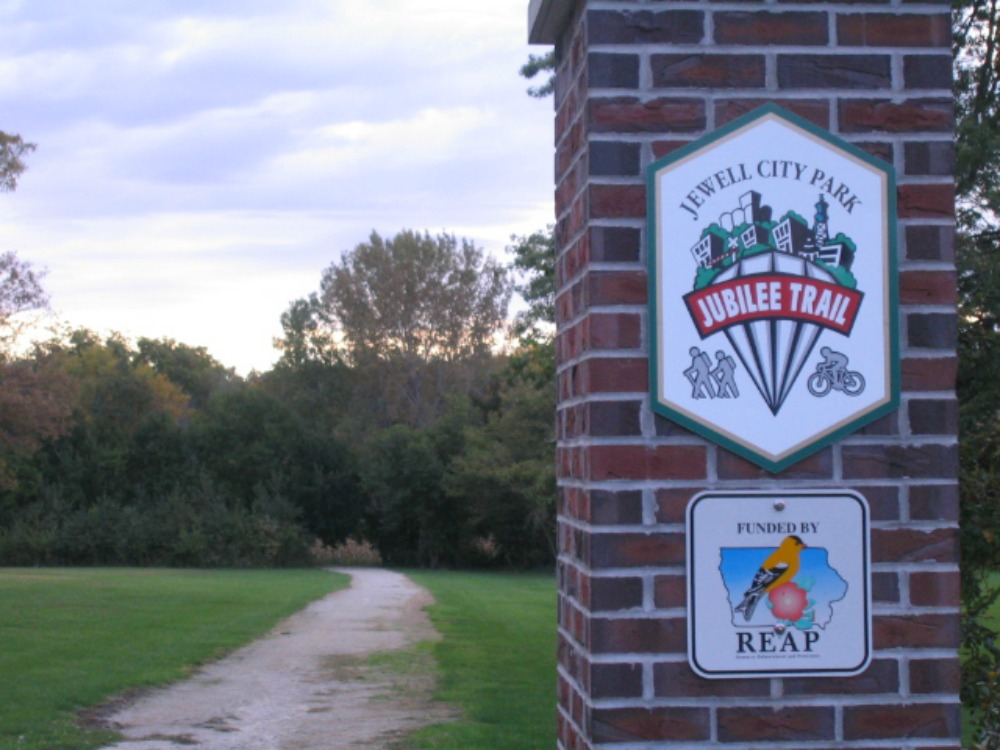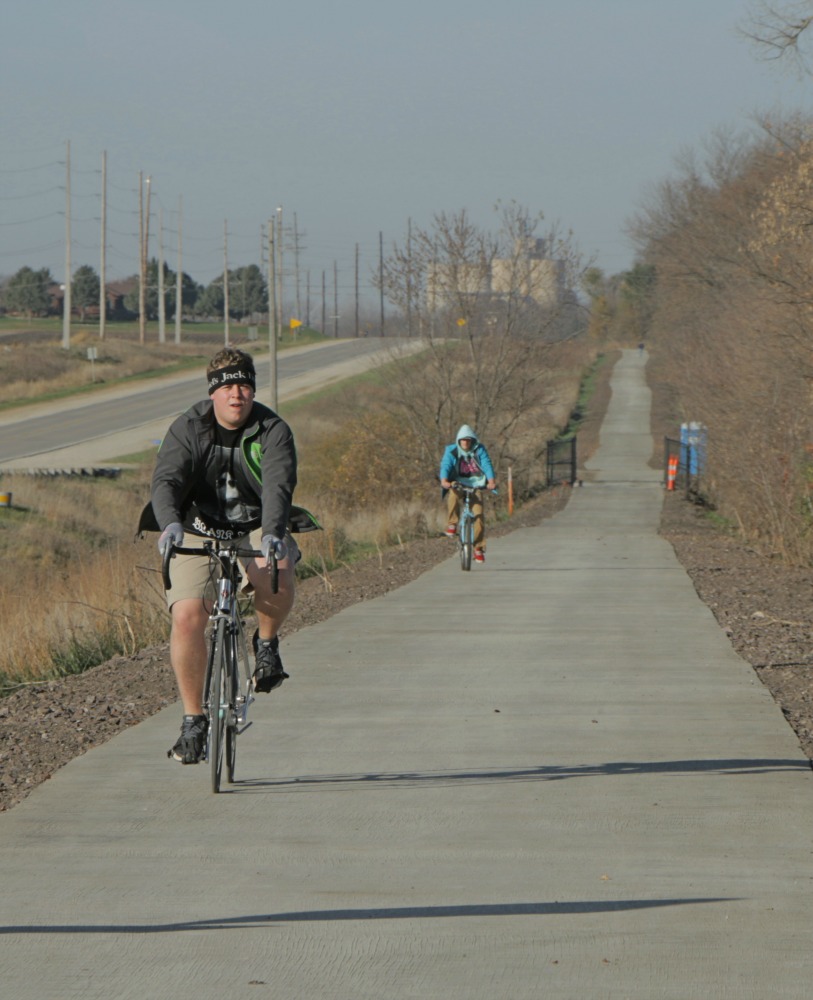A Trail of Two Cities
By Andrea Piekarczyk on February 24, 2017 in Blog
The story of the JewEllsworth Trail begins with the farm crisis of the early 1980s. For Rick Young, city councilman and lifelong resident of Jewell, the crisis was the beginning of the end for Iowa’s small rural communities. In Hamilton County, dwindling populations devastated cities long defined by hard work and heart. Those who remained, like Young, dedicated themselves to finding new opportunities for their communities — even crazy ideas like building a trail along the old railroad corridor between the central Iowa cities of Jewell and Ellsworth.
“It was about 2006 that we found out the rail line was being abandoned, and the community got together to discuss it,” Young said. “I looked around at all of us sitting there — we were in our fifties and sixties, farmers, rednecks… and we said, we’re not ‘trail people.’ Trail people are young — they bike, they run. But we also said, if this is going to be good for our community, we have to get on board.”

Brian Lammers, director of Hamilton County Conservation Board, recommended the local committee get in touch with Iowa Natural Heritage Foundation for guidance on how to bring a trail project to life. Once INHF was on board, Young said, things really started happening.
From concept to reality
In March 2006, the Union Pacific Railroad officially filed for the abandonment of the 3.2-mile corridor between the cities of Jewell and Ellsworth. Thanks to a State Transportation Enhancement grant, the two communities and Hamilton County were able to rail bank and purchase the discontinued rail line later that year.
In addition to the Union Pacific Railroad corridor, four more properties were needed to span the space between the cities, connecting downtown to downtown. Prairie Land Co-op, Heartland Co-op and the Anderson Lake Sportsmen’s Club donated a total of 6.7 acres to bring the trail to Jewell and Ellsworth city limits.
The final piece of trail property in Jewell was sold at a reduced price to connect the planned trail to the existing Jewell Jubilee Trail. With these additions, the future JewEllsworth Trail corridor now totaled 3.5 miles.
The generosity of these groups and individuals, and their commitment to a shared vision, was only the beginning of the fierce dedication the communities would demonstrate to the trail project over the next decade.
A waiting game
The JewEllsworth Trail was originally slated to be complete by 2008, but hoped-for grant funding did not materialize. From a funding perspective, INHF Trails and Greenways Director Andrea Boulton explained, the project was in a tough spot. Since the land for the trail was purchased, there was no threat of losing the connection. At the state level, precious few dollars are available for trail building: Money usually goes to regional projects or trails connecting large population centers.
“It might be logical,” Boulton said, “but it meant that this smaller project, and the two communities putting their hearts and souls into making it happen, were getting left behind.” Jewell and Ellsworth’s proposed grants missed the cut again and again, largely due to state grant program shortfalls. But the communities’ resolve never wavered, said Lammers. “Both cities [were] 100 percent in support of the project. They were instrumental in public support and conducting private fundraising projects.” From selling cookies to placing donation boxes in the local ice cream shop, the people of Jewell and
Ellsworth did everything possible within their financial means.

More than just a trail
How could a decade-long obstacle course possibly be worth the struggle? When asked, Rick Young’s answer was immediate: “Heart disease: It’s the number one killer in Iowa. It’s in my family and my wife’s.” From Young’s perspective, trails are a good value towards public health, both mental and physical. “And 10 years ago, that’s the last thing I would have said,” he emphasized.
The data backs Young up: Public open spaces (like trails and parks) have a powerfully positive impact on people’s activity levels. Studies show that adults living within half a mile of a public open space visit parks and exercise more often. And people who use public open spaces are nearly three times more likely than their peers to exercise at recommended levels. This is especially critical in states like Iowa, where two-thirds of adults and children don’t get enough daily activity, said Seth Johnson of the American Heart Association Iowa. “Access is half the battle,” said Johnson. “Having trails in place gives people more opportunities to get outdoors.”
Trails are also more than a recreational resource. For Jewell and Ellsworth, the JewEllsworth trail will serve as a safe transportation alternative for individuals and families living in the two communities. Kids can use the trail to travel from Ellsworth to county schools in Jewell, avoiding the hazards of Highway 175.
Coffee shops and restaurants, like Sweet Treats Homemade Ice Cream in Jewell and Down Home Restaurant in Ellsworth, make the trail a perfect activity for families to enjoy in the evening or on a weekend afternoon. “We’re expecting a positive financial impact from walkers and trail users,” Mike Miller, Sweet Treats owner, said. The JewEllsworth Trail provides a chance for visitors and residents alike to get out and see what the community has to offer.
For Boulton, this economic activity is another reward of trail building. “Maybe it wasn’t just the trail that did this, but the trail was a catalyst for change,” Boulton said. “Trails are these communities refusing to sit and wait for something to happen. It’s them saying, we need to make something happen. We need to move forward, not forgetting the way things were, but looking clearly towards the future.”

Looking towards the future is exactly what the people of Hamilton County are doing. “We want the best for our people, and we’ll do whatever possible to make that happen,” said Young. “The trail is a fantastic thing for our community. And when one community is successful, that success will be carried on to other communities.”
In 2013, cost-share funding for the JewEllsworth Trail finally came through in the form of a State Recreational Trails grant. It was an incredible moment. Lammers credits the funding to years of dedication and partnership finally paying off: “Over that time, working relationships turned into friendships… and that was really instrumental in getting this project done.”
The first time Young set foot on the finished trail it — well, it wasn’t quite finished. “The trail was paved, but the finishing touches were still being put on,” he said. “That was the first time I ever really experienced it as it is now. We had named one portion of the trail ‘Lammers’ Pass,’ in honor of Brian Lammers and all he did to make the project happen. I was scoping out a place to put the sign, and as I was taking it all in…” Young paused, emotional. “I felt like I was watching that last scene in “The Natural” with Robert Redford. He hits that home run, and everyone cheers.” A victory for all.
Take a virtual tour of the JewEllsworth Trail below: